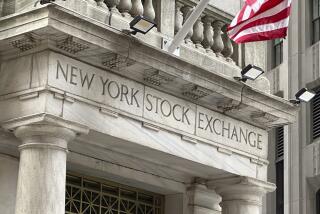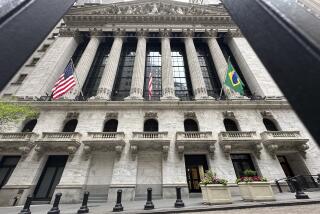Small Stocks Hold Their Own So Far
Stocks of many small and mid-size companies have been a great refuge for investors during the bear market of the last 2 1/2 years.
But can they lead Wall Street’s next phase -- whatever it turns out to be?
Thus far in the powerful market rally that began Oct. 10, smaller stocks have by some measures taken a back seat to blue chips, though marginally so.
The Standard & Poor’s index of 600 small-company shares has gained 19.3% and the S&P; mid-size 400 index is up 20.3%.
By contrast, the blue-chip S&P; 500 is up 20.5%.
However, a broader small-stock index, the Russell 2,000, has beaten blue chips, with a gain of 24.3% from its October low.
The horse race is important to many investors who are trying to decide how to configure their portfolios of individual stocks or mutual funds amid growing optimism that the long bear market may finally be over. Last week, the Dow Jones industrial average managed to notch its eighth straight week of gains.
The argument for smaller stocks -- which, of course, constitute the vast majority of the thousands of publicly traded shares -- is that, as a group, they usually lead coming out of bear markets.
In 1991, for example, the Russell 2,000 index rocketed 43.7% while the S&P; 500 gained 26.3%.
But the strong performance of smaller shares in new bull markets has stemmed in part from the fact that they usually have suffered deeper declines than big stocks in bear markets.
This time around, that wasn’t true. The S&P; small and mid-size indexes, along with the Russell 2,000, held up far better than blue chips in 2000 and 2001, and they have again this year.
That ended a five-year run, through 1999, during which the S&P; 500 reigned supreme. The winning streak pushed many blue-chip shares to extraordinarily high valuations by early 2000.
Now, three years of poor performance by big-name stocks could encourage more institutional investors to bargain-hunt there, if the economy continues to improve and hope rises about corporate earnings growth in 2003, some analysts said.
Steven DeSanctis, a small-stock specialist at Prudential Securities in New York, also noted that a shift to blue chips is an automatic move for many institutional investors as they structure their portfolios for a better economy.
“For pension funds, the first thing they do in reallocating money from bonds is to go to big-capitalization stocks,” DeSanctis said.
Big-name stocks also may have more room to revive if fear of financial scandals continues to recede, according to analysts. The most publicized scandals of the last year involved giant companies including Enron Corp., Tyco International Ltd. and WorldCom Inc., and that gave investors another reason to shy away from blue chips.
If those concerns fade, big-name stocks could regain their historic image as being less volatile and relatively safer than smaller stocks, said Russ Kinnel, director of mutual fund analysis for fund-tracker Morningstar Inc. in Chicago.
But John Rogers Jr., head of Ariel Capital Management in Chicago, which focuses on smaller companies, argues that investors often are less concerned about safety, and more concerned about opportunity, as faith in the economy returns.
“I think smaller-cap stocks will outperform large-cap because as people get more confident about the economy -- that the recovery is real -- they will be more comfortable taking the higher risk that smaller-cap entails,” Rogers said.
He said he favors such mid-size companies as retailer Tiffany & Co. and banking firm Northern Trust Corp.
Which market sector is cheaper based on valuation measures such as price-to-earnings ratios?
Calculating overall P/E ratios for major indexes is a dicey business, because in trying to represent all stocks in the index an overall P/E may end up representing only a hypothetical stock.
But for what they’re worth, P/Es based on estimated earnings per share for the S&P; 500 and the S&P; 600 over the next four quarters show the two sectors valued about the same (around 19 times earnings), according to Bloomberg News.
Kinnel said the valuation parity reflects the strong relative performance of smaller stocks over the last three years, which has lifted many of the shares from dirt-cheap territory in 1999.
A central question now is whether earnings growth in 2003 will be better at larger companies or smaller companies, on balance.
Historically, investors have viewed many smaller companies as generally having more pricing power because the companies tend to serve niche markets.
But Peter Larson, manager of the Liberty Small Cap Fund in Boston, said that although he has heard more lately about companies trying to raise prices, “I don’t detect a whole lot of optimism about price increases sticking.”
That’s one reason why “the biggest challenge now is finding cheap stocks where you have some conviction about prospects” for earnings gains in 2003, he said.
One sector where he has made some bets is trucking, Larson said. Companies such as Arkansas Best Corp. “have had to really run their businesses better” to generate earnings without the benefit of sales growth, he said.
If the economy accelerates in 2003, lifting truckers’ sales, the gains could flow directly to the bottom line, Larson said.
For individual investors who are trying to decide among mutual funds that favor small, mid-size or blue-chip stocks, they also must decide between funds in each sector that are more value oriented and those that are more growth oriented.
Just as smaller stocks have outperformed bigger stocks during the last three years, value stocks have trounced growth stocks, as investors have fled high P/E issues (especially in technology) for more reasonably valued stocks in more-stable, often slower-growing businesses.
So far this year, for example, the average small-cap value mutual fund is down 7.5%, while the average small-cap growth fund is down 23.4%, according to Morningstar.
Likewise, the average large-cap value fund is down 15.2% this year, while the average large-cap growth fund is off 22.6%.
But Prudential’s DeSanctis said that growth stocks usually lead value stocks coming out of market downturns, as investors’ enthusiasm resurges.
Plus, added Kinnel, with value in its third year of superior performance to growth, “I think growth is more on sale now.”
More to Read
Inside the business of entertainment
The Wide Shot brings you news, analysis and insights on everything from streaming wars to production — and what it all means for the future.
You may occasionally receive promotional content from the Los Angeles Times.










